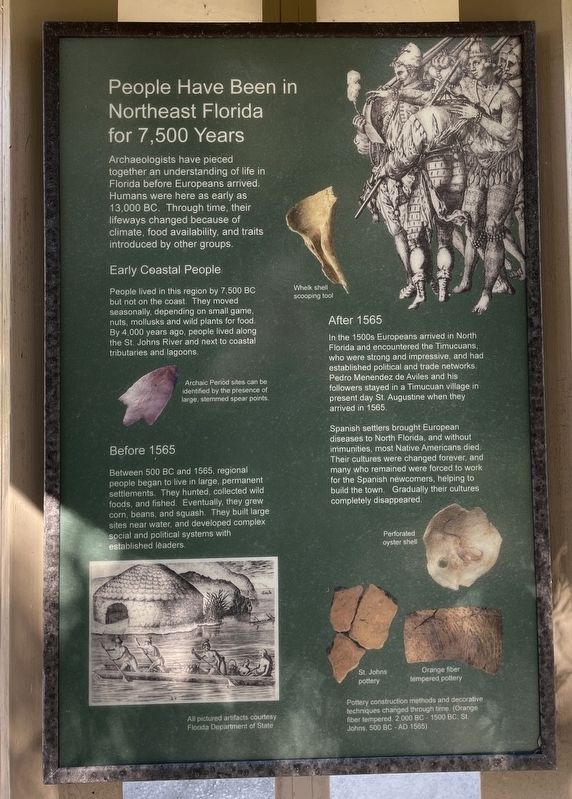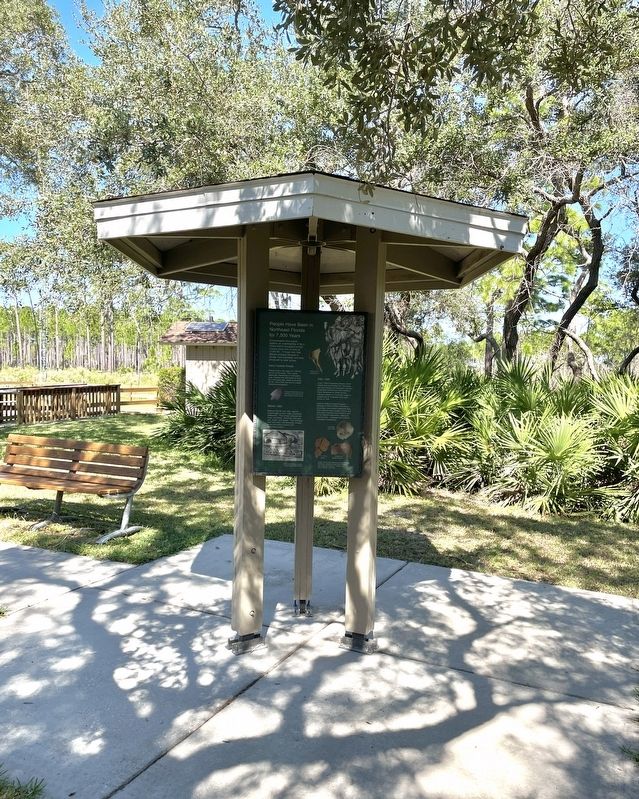St. Augustine in St. Johns County, Florida — The American South (South Atlantic)
People Have Been in Northeast Florida for 7,500 years
Faver-Dykes State Park
Inscription.
Archaeologists have pieced together an understanding of life in Florida before Europeans arrived. Humans were here as early as 13,000 BC. Through time, their lifeways changed because of climate, food availability, and traits introduced by other groups.
Early Coastal People
People lived in this region by 7,500 BC but not on the coast. They moved seasonally, depending on small game nuts, mollusks and wild plants for food. By 4,000 years ago, people lived along the St. Johns River and next to coastal tributaries and lagoons.
Before 1565
Between 500 BC and 1565, regional people began to live in large, permanent settlements. They hunted, collected wild foods, and fished. Eventually, they grew corn, beans, and squash. They built large sites near water, and developed complex social and political systems with established leaders.
After 1565
In the 1500s Europeans arrived in North Florida and encountered the Timucuans, who were strong and impressive, and had established political and trade networks. Pedro Menendez de Aviles and his followers stayed in a Timucuan village in present day St. Augustine when they arrived in 1565.
Spanish settlers brought European diseases to North Florida, and without immunities, most Native Americans died. Their cultures were changed forever, and many who remained were forced to work for the Spanish newcomers, helping to build the town. Gradually their cultures completely disappeared.
(captions)
Archaic Period sites can be identified by the presence of large, stemmed spear points.
Whelk shell scooping tool
Perforated oyster shell
St. Johns pottery
Orange fiber tempered pottery
Pottery construction methods and decorative techniques changed through time. (Orange fiber tempered, 2,000 BC - 1500 BC; St. Johns, 500 BC - AD 1565)
All pictured artifacts courtesy Florida Department of State
Erected by Faver-Dykes State Park.
Topics. This historical marker is listed in these topic lists: Colonial Era • Exploration • Native Americans • Parks & Recreational Areas. A significant historical year for this entry is 1565.
Location. 29° 40.219′ N, 81° 15.114′ W. Marker is in St. Augustine, Florida, in St. Johns County. Marker can be reached from Faver Dykes Road, 3 miles east of Dixie Highway (U.S. 1). Located on the grounds of Faver-Dykes State Park adjacent to the ranger station. Touch for map. Marker is at or near this postal address: 1000 Faver Dykes Rd, Saint Augustine FL 32086, United States of America. Touch for directions.
Other nearby markers. At least 8 other markers are within 3 miles of this marker, measured as the crow flies. Welcome to Hiram Faver Trail (here, next to this marker);
Early Settlers on This Land (here, next to this marker); Princess Place Estate (approx. 1.2 miles away); Marineland-The World’s First Oceanarium (approx. 2.3 miles away); Marineland (approx. 2.3 miles away); Submarine Hill (approx. 2.4 miles away); Middens And Mounds (approx. 2˝ miles away); Coquina (approx. 2˝ miles away). Touch for a list and map of all markers in St. Augustine.
Also see . . . Florida State Parks. (Submitted on October 16, 2022, by Brandon D Cross of Flagler Beach, Florida.)
Credits. This page was last revised on October 17, 2022. It was originally submitted on October 16, 2022, by Brandon D Cross of Flagler Beach, Florida. This page has been viewed 104 times since then and 18 times this year. Photos: 1, 2. submitted on October 16, 2022, by Brandon D Cross of Flagler Beach, Florida. • Bernard Fisher was the editor who published this page.

